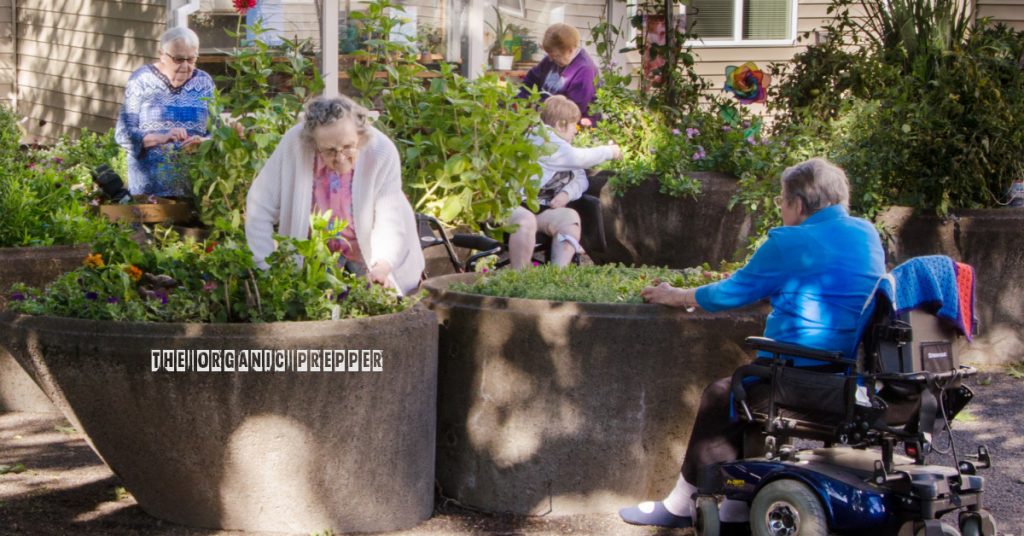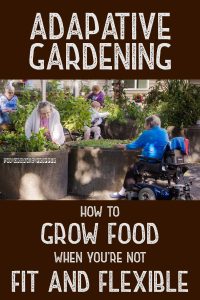If you're new here, you may want to subscribe to my RSS feed. Thanks for visiting!
Gardening is a very physical activity. Between planting, weeding, pruning, watering, and many other chores, it’s good exercise! It gets to be challenging when one factors in various kinds of disabilities, up to and including old age. That’s where adaptive gardening comes into play.
I learned about adaptive gardening the hard way.
I remember when my back went out in 2017. I had three slipped disks, two lumbar and one thoracic, one of which liked to hit a nerve when I was sleeping too well. In the first year, getting out of bed was a challenge! That’s the year I grabbed a field guide and my plant ID app and learned about my backyard. I had four pitiful pots of salad greens growing and that was it! I did, however, learn a great deal about the bounty I had under my nose. That was the year I joined the chronic pain club thanks to age and occupation-associated lumbar degeneration, and I was determined to continue gardening.
I didn’t know at the time that there was a name for this. I simply adapted and adjusted. The name for this kind of gardening is adaptive gardening, and the concept is pretty simple: make small changes in your habits to accommodate your new reality. Simple enough, right?
Also, be mindful of how you think. I worked on a book that year discussing motivational approaches to chronic pain, and the major takeaway was to guard my thinking. Studies quoted showed that people who focused on the pain tended to get worse and do less, whereas people who focused on doing the things they wanted to do were happier and did more. Yes, proper medications help, but I don’t allow myself to become dependent, either. I’ve been able to stick with OTC meds and add things like CBD.
A friend from the gun range has rheumatoid arthritis, and her hands are seriously messed up. And yet, she shoots competitively, often ending up ranked in the top ten. Because she adapted and guarded her thinking. My garden mentee last year was in a wheelchair, and she gardened. It CAN be done.
Adaptive gardening starts with planning.
How you go about this depends upon exactly what disability you have, but it starts with garden planning. In my case, I turned three of four raised beds into perennials, planting asparagus and strawberries that would come back every year. This cut down on the amount of planting I had to do. I also bought good knee pads, which help my back immensely! Two of those beds are still in perennial, but I can handle the extra work now as the discs healed.
Other gardeners use garden benches and sit while weeding. I lie on my side after a certain point. Another option is an elevated planter, which many gardeners with back problems find much easier to work with. Containers and flower boxes also help, and don’t forget your soaker hoses! Those are much easier to deal with than hauling buckets, especially if you’re in a wheelchair.
Get the right tools
If your hands are the problem, The Family Handyman has some tips for you! Starting with ergonomic gardening tools, which are designed to keep hands and wrists at a more natural angle for easier working. Cordless hedge trimmers keep electrical cords out of your way while ratchet pruning shears require much less hand strength.
The Ideas website also offers some cool tips. I’d never thought of retractable hanging baskets, but I have used containers on wheels and they’re so much easier to work with! The Backyard Garden Lover also shows some cool tools and garden configurations for people with disabilities.
Here are the concepts of adaptive gardening.
The common concepts of adaptive gardening shown in these references are these:
- Assess your situation to determine your garden plan. Are you dealing with arthritis, back problems, a wheelchair? What are the new rules?
- Make your garden space accessible. If you need wide paths, make them or have them made. Use raised beds, containers/containers on wheels, retractable hanging baskets, and elevated planters to put your space within reach.
- Ergonomic tools, extenders, and tools that require less hand strength can be very helpful! I love my knee pads. I know of a gardener who made a seeder from some PVC pipe and a collar. She drops the seed down the pipe into the furrow. The collar is attached 1 inch up and adjustable to what she’s planting, so the seed goes the correct depth. The collar also has a side arm to help her space her seed. This was made from materials she had around the house. Are there any materials you could use to make, or have made, the tools you need?
Don’t forget your mindset!
And remember above all things: keep a positive mind!
The benefits of gardening are many, especially for the disabled gardener. From the sense of accomplishment that comes from growing even some of your own food to the peace that comes with working in nature, there’s no way to beat gardening.
I’ve met some cool people and learned some new skills. Gardening can even help develop fine motor skills in some cases! I’ve found a great deal of purpose in gardening, and the exercise has helped me heal as much as I’m able.
And how about the taste of homegrown? Nothing beats it! So adapt, adjust, and garden!
 What about you?
What about you?
If you’re looking for more advice on how to have the most productive and efficient garden ever, check out our very popular Home Agriculture Comprehensive online course.
Have you ever had to change how you garden due to injury, illness, or age?
What adjustments have you had to make to overcome? What are your recommendations to others? How did you keep your mind in a good place?
Let’s discuss it in the comments section!
About Amy Allen
Amy Allen is a professional bookworm and student of Life, the Universe, and Everything. She’s also a Master Gardener with a BS in biology, and has been growing food on her small urban lot since 2010.


















Just found this, might help somebody. https://www.familyhandyman.com/article/hay-bale-garden/
Anyone else getting hit with unseasonable cold weather, 52 this am in NC!
9C in Nova Scotia! Constant chemtrailing really does make ‘climate change’. We seem to be locked into a cold weather pattern here for the last 2.5 months & also unusually windy.
Straw bale gardening is quite popular actually! Joel Karsten has a book and a great website: https://strawbalegardens.com/
My husband built a greenhouse this spring and it has raised beds. Good for us retired gardeners, and protects veggies from rural critters.
That’s great! Urban critters visited my community gardens plot this morning and ate my fennel 🙁 The plants were free and at least they’re leaving the other stuff alone, but it’s still annoying. As for raised beds, I love mine! I also love my elevated planter even though I’m not using it this year. Adapt and adjust, right?
My husband and I are in our sixties. We started planting in raised beds last year and this year expanded our number of beds. Raised beds will be extremely useful in the future as we get older. They decrease the amount of time that we need to weed.
We also started raising potatoes in grow bags. We had tried to grow them and sweet potatoes in tires last year, but the tires were heavier than we wanted. Planting them in our hard clay ground makes it difficult to harvest in the heat of the summer.
I have clay ground also, which is another great reason for raised beds. You can put better soil in. I’ve had varying degrees of success with grow bags but I’ve always gotten something! Thanks for the comment.
Thanks for a wonderful article Amy.
Grow bags are great, I have sweet potatoes, ginger, and peppers in them.The smaller sweet potato bag is on a chair, cause the bunnies were getting the munchies. Also I have a gorilla flat bed cart. The wide wheels make it easy to tote things around.
You’re welcome! Glad I could help.
Important topic. I don’t see this discussed often enough.
I work on a lot of gardens in my business and I get to see many adaptations that help plus situations that make it more difficult. If you’re in the planning stage for a garden or property it really helps to try to avoid steep slopes. As age or infirmity creeps up, having to work on slopes or go up and down them gets more difficult.
Raised beds that are several feet high are amazing. I have elderly clients who garden in them and they are so productive and easy to use.
Keep pathways free from slabs of lose stone or other things that will trip you. A landscape fabric covered area with pea stone atop makes a wonderful choice to go around raised beds.
When possible opt for dwarf or semi dwarf fruit trees; way more accessible and easier to work on and harvest.
Keep weeds from setting seed and getting out of control in the first place. I often get panicked emails from people who couldn’t keep up with the garden due to disability and now it’s a disaster area they have no hope of tackling.
If there are chores that really tax your body, hire someone to do those. I have clients who are still able to do much of their gardening but hire me to do specific tasks that are a problem for their body.
Thanks for the great tips!
This was really interesting. One thing I’ve done is to use apple bin boxes my neighbor gave me. He filled them up with dirt using his tractor. (I take care of his dog often in exchange.) He also looks for a place to get rid of his grass clippings, so I instructed him to dump them between the bins. I spread them out with a rake and that stops all the weeds from growing between the boxes for years. (He’s got a huge lawn)
Do you use the apple bin boxes as containers? Or raised beds?
Smoke from Canada has arrived in South Central PA again. Got the burn ban and air quality alerts today (those are for the rest of the week, possibly into next week as well). Husband dug a hole for my new clothesline – a foot deep and dry and dusty all the way to the bottom. We’re having to water some trees that we planted two years ago, plus the ones planted this spring, as well as the garden. Giving it just enough and praying that the plants survive. Next possibility of rain is Sunday (6/11/2023) and that’s only a 40% chance for my area. Praying what fruit we do have on the trees stays there, but if it’s the choice between fruit and tree – I’ll take the tree and get fruit in a better year….
Still praying for rain – a gentle soaking rain for a couple of days would really help.
I like the Youtube channel, The Provident Prepper.
The lady on there has MS and has adapted very well.
She has outdoor gardens and raises greens, beans, tomatoes and peppers indoors, too. I hope to try that soon.
I have some raised beds and also have a rolling seat that helps a lot and love my soaker hoses.
I also use a battery operated Mantis tiller that works great!
I am very sensitive to heat, so do all my yard work in the early morning hours.
Almost anyone can raise at least some of their own food.